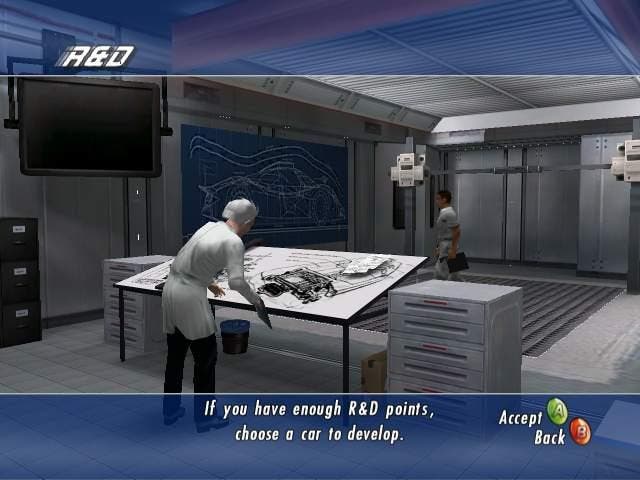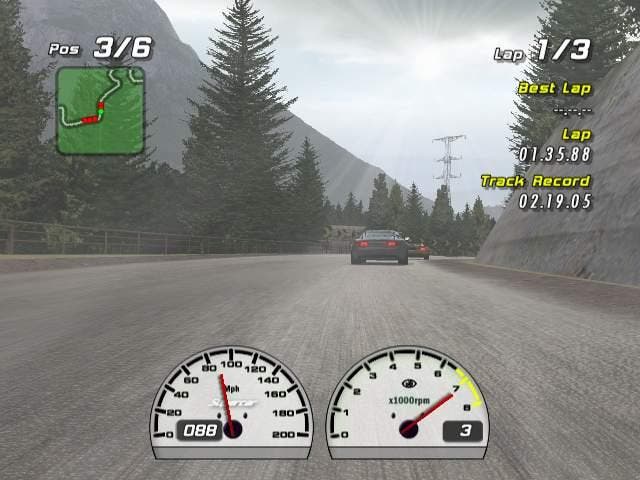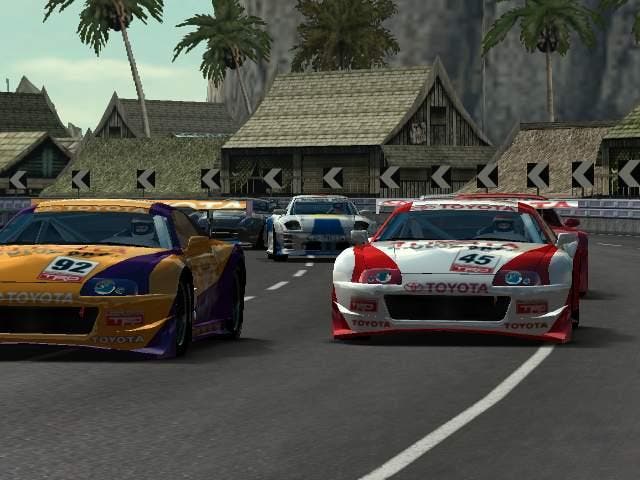Racing Evoluzione
Review - can the chaps behind Screamer produce the best Xbox racer since Project Gotham?
Do you realise that, over the next few months, a racing game of some description is due out every Friday? Dates may change and you may not care about 90 per cent of them, but they all cross our desks and we have to give them all a bit of time and appreciation.
It's a situation that hasn't changed much since I started the job. The first review I wrote for this organ was about a racing game, and there have been many more since. So believe me when I say that a racing game has to do a lot to make a serious impression on me. Last year only produced a handful of examples.
Racing Evoluzione is the first game to make this year's list.

Why?
First and foremost, Racing Evoluzione distinguishes itself by keeping things relatively simple. Load up the game and it doesn't address you with seventeen different variations on lap racing and another dozen concerned with time trials. There's Dream Mode, Arcade Mode and Options. Arcade mode opens up to reveal Quick Race (pick a track and pick a car), Time Attack (the now fairly standard name for a Time Trial mode), and One-on-One (which is for the two-player split-screen mode).
Dream Mode, on the other hand, is a very different proposition to your average "Campaign", "Career" or "Championship" option. Instead of picking a car and then buying better ones or simply unlocking them as you go, you start off your own car manufacturer, building a car up from blueprints and entering races to impress people and pick up orders. The game begins as you dust off a rundown corrugated iron garage with your Joey-From-Friends mechanic, who luckily discovers a set of three concept car blueprints, from which you'll build your company's first car.
"Six months later", your garage looks a bit tidier, with a bookshelf storing game options (something Joey is very surprised to find himself telling you about), a calendar on the wall listing the two championships you can enter (and the 37 others you can't until later), which acts as a gateway to racing, and the workshop floor, where you can see your car, tweak engine options and head out onto the test track (a car park - how sweet!).
Finish your first few races ahead of the pack (we varied between first and fourth - the qualifying bracket) and Joey will tell you that orders are flying in. Moving onto the new production department, you can check up on sales. When you have 100 sales, you can choose to build another Roadster, or wait until 300 to build a sports car. This goes on in R&D, where you pick from other blueprints. And so on.

Nitty gritty
However, despite the depth this approach implies, it feels more like window dressing for a normal racer. Building your own cars is a nice idea, but you don't have any say in how they look (other than colour) or even much say in how they handle. You can select between normal and drift handling to begin with, and then you open up gear ratio options and a little more later on - but never a huge amount. Fortunately the options you do change make an appreciable difference. Switching to a low gear ratio will improve your acceleration and likewise, switching to drift handling gives the game more of a Ridge Racer feel than a GT one. Of which more later.
And even the principle selling point - the idea of running your own car company - is pretty much just a Ridge Racer style "excuse". As you get better and better, Joey tells you to hire secretaries and you see more staff milling about, but you have little to do with them and don't get to pick them. This isn't Theme Hospital for cars, sadly. What's more, the sales figures (which unlock more R&D funds) are a simple substitution for points. Win a race and you get a set number of sales, then slightly lesser figures for second, third, fourth. It's not all that original. The only real difference is in small diversions offered between some championships, like a wealthy Sheikh ordering a demonstration, and buying 25 cars for his family if you win - but these seem similar to the equivalent "challenges" thrown at you in games like Gran Turismo and TOCA Race Driver. So on the whole, although a nice aesthetic for a racing game, Racing Evoluzione's exciting new angle isn't much more than a nice menuing system.
Or it would be, except the presentation is good enough that you don't care. Your garage is a nice layout and more interactive than the (similar) office/garage setting in TOCA. Your mechanic is a jovial, friendly chap who doesn't blurt out appalling Ridge Racer/Auto Modellista-esque one-liners like "you'd better teach me how to race!" and instead stands on the sidelines to encourage you. And after a while you move to bigger premises. And as you win championships, you unlock the real cars, which your competitors drive for Arcade mode. Toyotas, Mercedes, Lotus, Renaults, MGs, Fords, Chevrolets, Mitsubishis. Everything you'd expect. It does feel like progression as you gradually build more and more explosive cars, right up to Concept Dream Cars and so on, and it does feel like a story, without the race-fixing and Yank petulance which disrupted TOCA's efforts.

And then there's the racing�
And indeed, then there's what goes on between the start and finish lines. On a graphical level, this is on a par if not beyond Project Gotham, which remains one of the most beautiful racing games we've ever set eyes on. The level of detail on the cars is fantastic, although the damage model is slightly odd (with visible tears in the metalwork at times), but the reflections work brilliantly (whether they are real time or not) and the concept cars designed for the game fit in perfectly snugly with real world equivalents on the race course. Meanwhile, the trackside scenery is colossal in scope and nothing less than brilliant in execution. Dazzling light effects play a big part, as the road sizzles under the sun and the glare forces you to take a cautious line at times, and landmarks pepper the scenery: flyovers arch into the sky, mountains glisten with snow, which piles up on the side of the track, cars can be seen minding their own business slowly pottering around behind barriers, aeroplanes pierce the vista as they swoop low towards airports, and on the whole there is always something happening on-screen, and never a dull moment. Our only complaint is that you'll rarely see much of it because you spend most of the time with your eyes on the road.
The tracks aren't all urban jungles either. You can pick from city, mountain, racetrack and speedway (think NASCAR bowls), and many of the individual tracks have been designed in the same way as Project Gotham's offerings, snaking over the same broad design and thus rehashing bits of each other to great effect. It works just as well here as it did there.
Oh, and despite throwing around more polygons than any other Xbox racer we've seen, Racing Evoluzione rarely if ever skips a frame. And that includes our appraisal of the two-player split-screen, which was examined at jaw-to-the-floor inducing length. It looks more or less exactly the same to our eyes as it does when plastered over the entire TV. Glorious. Other bits of gloriousness? 5.1 surround sound, which had us oohing and ahhing, 480p progressive scan support for HDTV nutters (according to what we've read anyway), and the welcome inclusion of custom soundtracks, even if the game does pick one song per race and replays it until you finish.

Pre-race physical
We know what you're thinking. There's a question forming in your mind which goes something like: "So it looks good, it's technically excellent, even if the whole car company idea is a bit lean, but how the blummin' heck does it play?" Well, somewhere between pure arcade racers like Burnout 2 and out and out simulation titles like Gran Turismo 3 lurks a little niche of half-breeds - and nearly all of these titles are exceptional. Ridge Racer Type 4 and Project Gotham Racing are our favourites, and Racing Evoluzione's efforts also fit into this category.
The game isn't a true simulation. It sacrifices elbow grease and cuts corners if it means entertainment. The racing model is somewhere between Gotham and Gran Turismo, with appreciable variance in handling on different cars and a handful of tweakable options, but by massaging the brakes and gas you can still swing the rear end about like your car's a curvy blonde from Spearmint Rhino.
Coming to it off the back of games like Burnout 2 and Gotham, the handling feels a bit awkward - switching on drift helps, but it's still neither salaciously unrealistic nor a brittle reconstruction. However, with five or six races under your belt, you start to appreciate it. After five or six competitions, you're sliding with the best of them and wringing the physics model for all the extra oomph it can offer. And after 15 hours or so you feel as hopelessly hooked as you did with Bizarre Creations' offering - the only possible complaint being the lack of a Kudos system equivalent and the strict adherence to racing, racing, racing.
What may derail you at this point is the AI, which not only has the frustrating tendency to cover enormous distances whenever you slip up (or come to a dead stop because you hit a sharp edge on the inside of a turn, grr), but also seems to avoid deceleration on grass verges and other surfaces that blight your efforts. The developer does go to some effort to emphasize the other drivers' fallibility, as they overcook turns and lose places to one another in your rear-view, but it smells like a cover-up. I think the other drivers cheat. Still, at least they don't snake their way around the track like GT's boring opposition does - there are real battles going on here, and it feels like a race.
And for us, the challenge to the strength of the game's 'feel' posed by the AI's flaws merely serves to reinforce RE's greatness. We persevered with the tricky AI, and became a better driver. You can judge most turns by using the little map in the top left and keeping an eye on the road, and it spurs you on when you cock it up on the second lap of four and your previously distant rival suddenly speeds past you.
Final lap
At the end of the day, the effect RE's flaws have on the game's worth is subjective, and for us they fail to outweigh its visual and physical excellence. We can put up with the sound of someone smacking a tin sheet with a hammer whenever we nudge a competitor (which is roughly what it sounds like), we like the trumped up 'Dream Mode', and we've overcome our dissatisfaction with the AI. We firmly recommend Racing Evoluzione to people who can do the same - other than that, it's only a few lengths behind Project Gotham (which offers slightly more variety), and perhaps, dare we say it, Ridge Racer Type 4.
If only it had Live support.

